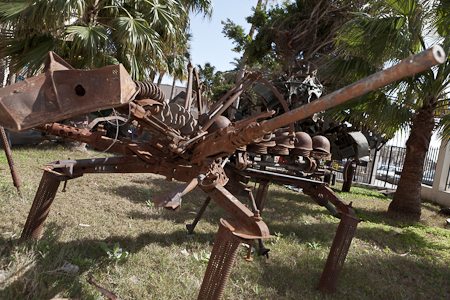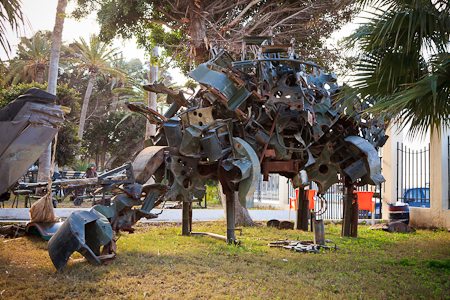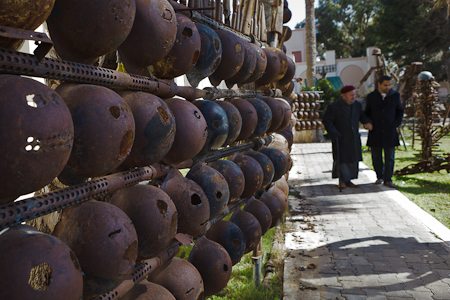
Ali’s sculpture The Ant represents the Libyan people. “Gaddafi told us we were insects, OK then, we might be ants, but we are huge ants!”
Three months after the first revolutionary spark was lit in Libya’s east, one of Benghazi’s greatest artists started sculpturing pieces of a whole new kind. Ali Al-Wakwak, an artisan since 45 years, began collecting rusty weapons and military leftovers from the battlefield. In his hands, the instruments of death are turned into pieces representing new Libya’s life.
A five minute walk from Benghazi’s waterfront plaza, now known by its post-Gaddafi name Liberation Square, sits one of the city’s grandest historical houses. The story of the building reflects that of Libya’s modern history: just like the proud Saharan country, this sand-coloured house has transferred ownership from the Italian colonialists to King Idris to the former dictator Muammar Gaddafi. After last February’s liberation of Benghazi, the house came in the hands of the city’s revolutionary fighters. A couple of months later, Ali moved his studio here and started working.
“I started creating art from burned vehicles during the revolution. It was very intense at that time. There was a need for expression.”
“This place is full of history,” says Salwa Al-Tajoury, a close friend of Ali’s and an artist also exhibiting in the house. “It was built during the Italian colonisation and used to belong to Graziani, the leader of the Italians in Libya. There’s still some Fascist mosaic left on the floor. After independence, it became King Senussi’s home. It was here that he declared Libya’s independence in 1951. The place was later offered to a university. When Gaddafi came to power, he took the house for his own purposes. It was used for business meetings; Gaddafi once received Berlusconi here. Now, after the revolution, it has become an art exhibition.”

The Dinosaur symbolises Gaddafi. “Just like the dinosaurs, he’s now extinct.”
The main part of the collection is made up of Ali’s sculptures. Rusty and heavy, most of them large enough to climb upon, they fill most of the garden outside. The pieces are put together of rough chunks of iron, tossed weapons and parts of military vehicles; airplanes, army jeeps and tanks.
“This place is full of history. It was built during the Italian colonisation, there’s still some Fascist mosaic left on the floor.”
“I started creating art from burned vehicles in May, during the revolution,” says Ali. “It was very intense at that time. There was a need for expression. And there was plenty of material everywhere. Burned things, which took many different forms. I always liked to work with recycled material, and I wanted to show the world that beautiful things can be made out of these rests.”
The material comes from a war that has killed and injured several tens of thousands of Libyans. Yet the sculptures have a strong sense of life to them. Almost all of Ali’s pieces are living creatures: animals, large insects, revolutionary fighters, ordinary Libyan men, women and children.
“What I love is the transformation of war material into something beautiful. Things that have been burned and broken, they should not be thrown away. They capture how it is to be a human being,” says Ali.
“What I love is the transformation of war material into something beautiful.”
Born in 1947, Ali always worked with creating things with his hands. As a boy, he was taught to make traditional wooden plates by his father who worked as a craftsman. For many years, Ali was a wood artist, sculpturing typical Libyan pieces: camels, figures of the Tuareg people. He sold these in galleries abroad, and to tourists who came to Libya. But it was difficult being an artist – and a free spirit – under Gaddafi’s regime.

Faces of War is made by corroded helmets and military leftovers. “It symbolises that people don’t learn from history.”
“Before the revolution, there were many things that I wanted to do with my art yet couldn’t. I wanted to express freedom. But I was limited in my creativity. Green, for instance, the colour of the regime, was the only one allowed. I had to be careful when choosing colours for my works,” says Ali. “But I did make some pieces that spoke about freedom. Small sculptures with masks, symbolising people who can not see or speak freely. They gave little winks to the tourists who bought them. The same with my Tuareg figures. I love them because they have hidden faces, showing no expressions. That’s exactly how we lived in Libya.”
Like so many other free minds in the country, Ali experienced the harshness of the regime personally. In the eighties, he spent seven years in prison for refusing to join Gaddafi’s war in Chad.
“Before the revolution, there were many things that I couldn’t do. I wanted to express freedom. But I was limited in my creativity.”
“They put me in the military prison Abu Slim because I refused to go to war and kill people. I was lucky not to be tortured, but I spent years in a small cell together with seven or eight other people, without books, without anything.” Ali continues, “My son was also in jail. He is 27 now, when they caught him seven years ago he was so young. He hadn’t done anything wrong, the only thing he did was praying a lot. But he’s not an Islamist, only a devoted believer. Gaddafi was afraid of those. He was tortured in prison of course, they all were. For four years, I didn’t see him. After that I could visit him once every three months. It was only now after the revolution that he came out of prison.”

For Ali Al-Wakwak, an artisan and sculptor for 45 years, there are now no obstacles to his artistic freedom.
Ali’s family is gathered now, after the release of his son from jail. His other son, also an artist, lives in Tripoli. The sons were both at the front during the revolution. “But we were all at the front in a way,” says Ali, “doing what we could do. I couldn’t go there myself, so I’m doing this instead.”
Ali smiles, looks around the garden. There are sculptures everywhere; he has been working at a remarkable speed during the past nine months. At the entrance is the largest of his works, a heavy dinosaur looking out over the Mediterranean sea. “It represents Gaddafi,” says Ali. “Just like the dinosaurs, he’s now extinct.”
“I want to get the fear out of the children, they saw so much during the war. I want them to see the weapons transformed.”
Next to it stands another tall figure, a woman with long limbs and a skirt made of hundreds of empty bullet shells. She is a thuwwar, a revolutionary fighter. “The sculpture represents the strength of the Libyan women, their contribution to the revolution,” says Ali. “They played a huge role, that’s why I made her so tall.”
Salwa, Ali’s friend, fills in. “He really wants to show that women were part of the revolution. He wants them to be seen and recognised. Ali is a feminist, which is something very rare for Libyan men, especially at his age.”
Every single sculpture in the garden bears a message. There are small animals and creatures everywhere, with moving parts and heads that sway up and down when touching them. These are for the kids who come to the exhibition, explains Ali. “I want to get the fear out of the children, they saw so much during the war. I want them to see the weapons transformed.”
A centipede made of rusty helmets curls around a palm tree, it’s head and front legs climbing up the trunk. The animal represents the Libyan people, now aiming upwards, towards the sky. Then there is a huge ant, made of rifles and corroded parts of a military jeep. Another symbol of the Libyan people. “Gaddafi called us insects, that’s what inspired me to make this one,” says Ali. “The sculpture says: OK then, we might be ants, but we are huge ants!”
“There are no obstacles to my work any more. I’m free now.”
The most powerful, and yet to be complete, piece is Faces of War. Just outside the eastern flank of the building, on a row of wooden poles, hang more than 200 rusty helmets, all with sad and sober faces. On top of the piece sit detailed figures made by bullet shells from World War II and totem poles in wood and metal. “This work symbolises that people don’t learn from history,” says Ali. “The totems represent the native Americans, whose lifestyle got exterminated. I started this piece in May. Then, as more and more people died in the war, it grew larger.”
Ali goes to the studio every day, starting his sculpting in the early morning. There is an abundance of material for him to work with; leftovers from the war are plentiful in Libya now. Remnants of death, waiting to be transformed into life by the prominent Benghazi sculptor. “I wish there would be no nights so that I could work all the time,” says Ali. “It’s like feeling hunger and wanting to eat. And there are no obstacles to my work any more. I’m free now.”
Photos by Karim Mostafa.


